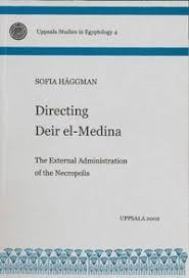
This study analyses the administrative structure of the Theban Necropolis, with focus on the changes it underwent in the mid- and late 20th dynasty. The structure of the administration is studied in terms of a patterns of contact between the Necropolis and officials representing other institutions. The officials and institutions that are discussed are the king, the vizier, the mayors of Thebes, and the House of Amun, most commonly represented by its head, the high priest of Amun.
The analysis is divided into four chronological phases. The 19th and early 20th dynasties (c. 1294-1153 BC) represent a period during which the administration followed the pattern established in the late 18th dynasty. This phase of relative stability is followed by a period of change in the mid-20th Dynasty, including the end of the reign of Ramesses III as well as the short reigns of Ramesses IV-VIII (c. 1153-1123 BC). The source material from this period reflects a change in the patterns of contact between the Necropolis and external authorities.
An examination of the administrative patterns of the late 20th Dynasty, covering the reigns of Ramesses IX-XI, with the era termed wHm mswt, (c. 1123-1070 BC) as well as the early 21st dynasty (c. 1070-996 BC) concludes the study. The administrative structure detectable in the documentation from the reign of Ramesses XI is further crystallized in the wHm mswt. In the 21st Dynasty the same pattern is found in a more condensed form, as formerly independent offices linked to the Necropolis are merged and held by one person, as the complex central government of the New Kingdom is replaced by a regional administrative focus.
This study also deals with the effects that these changes had on the workmen’s community of Deir el-Medina. In this context the abandonment of the walled village and changes in the character of Necropolis work, as well as in the internal administration of the work force, are discussed.

